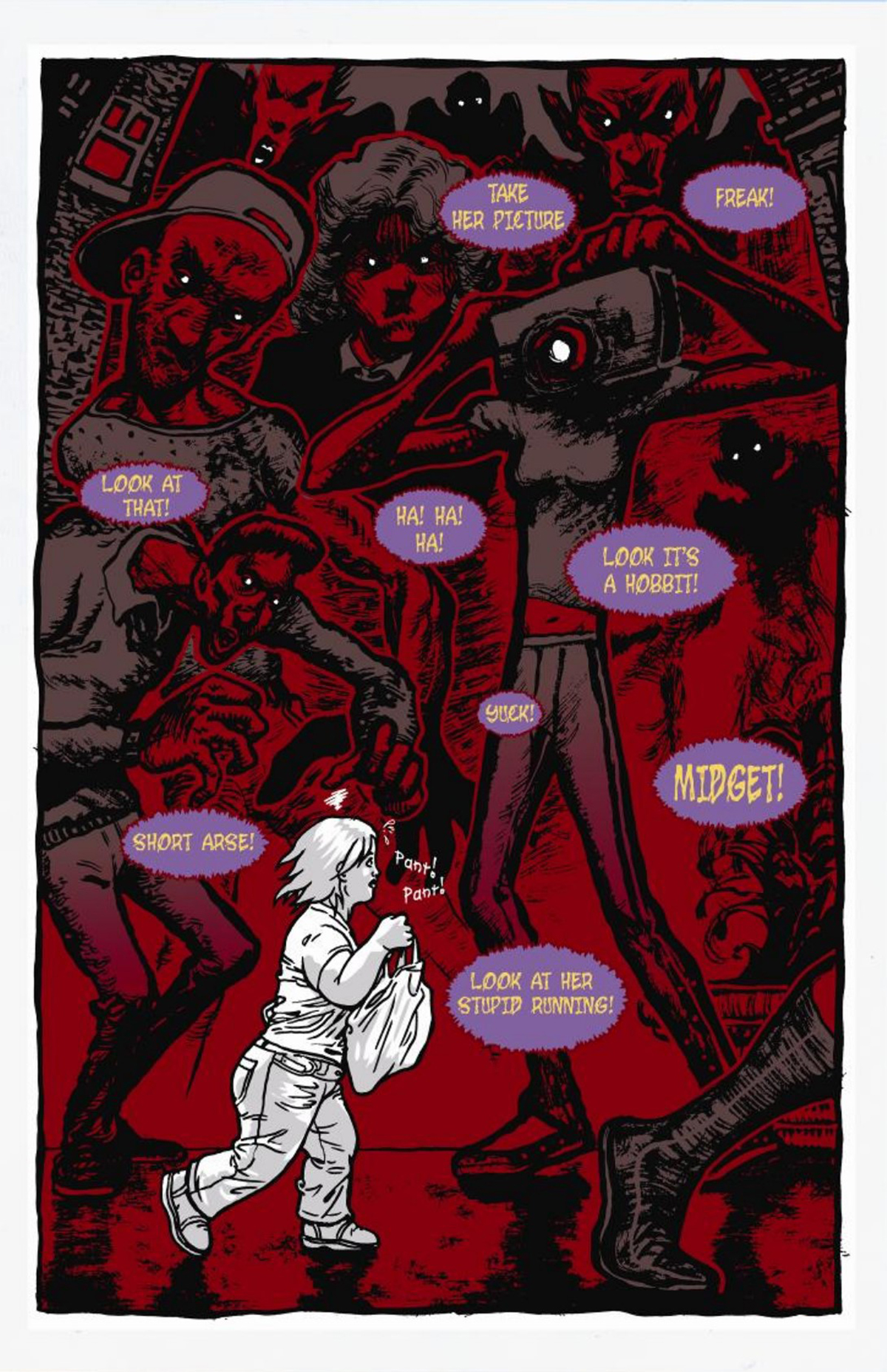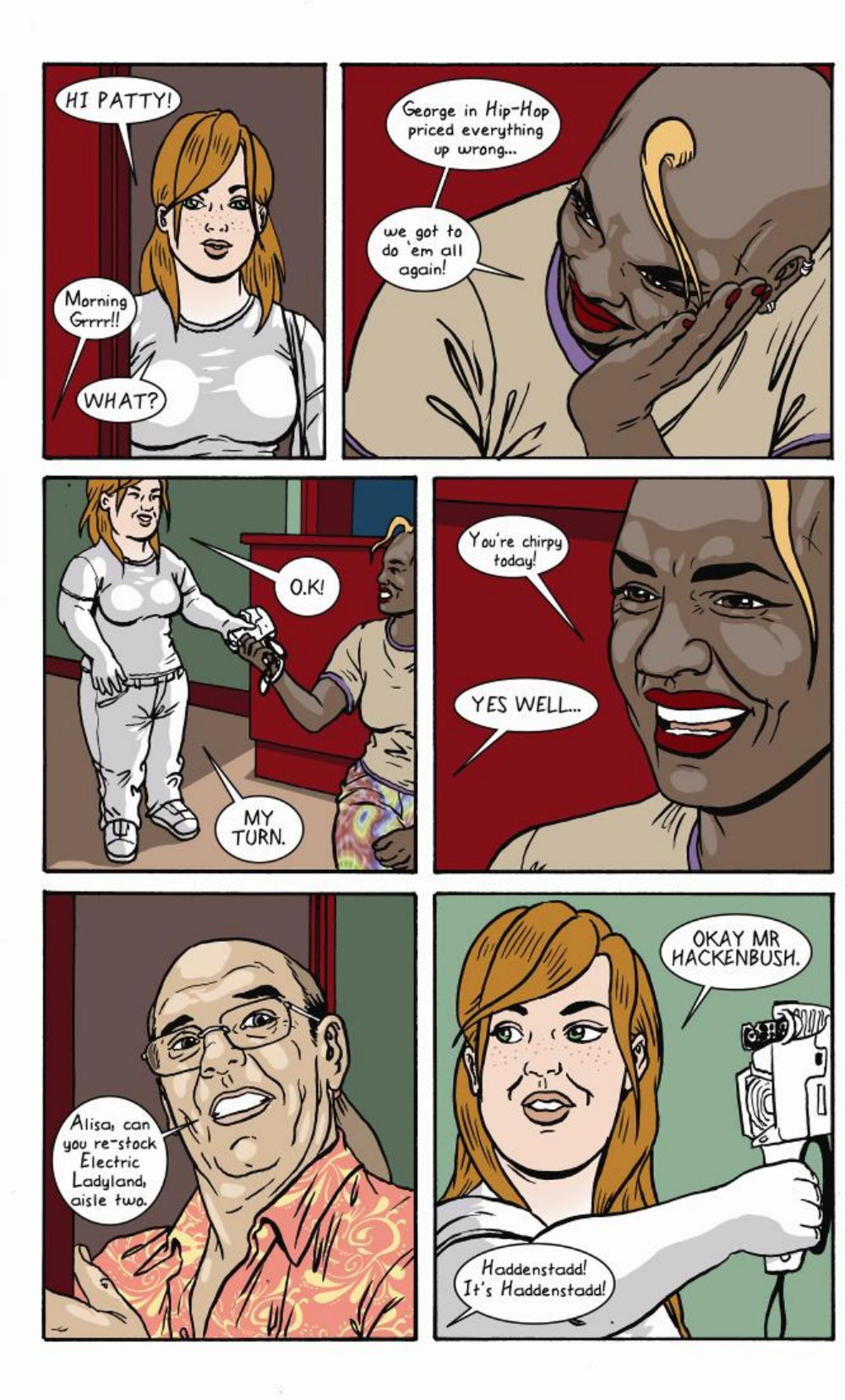Introduction
Alisa’s Tale (A short story) (Davison, 2013) is a comic about a young woman with a form of dwarfism known as Achondroplasia. Achondroplasia is the most common form of dwarfism. There are approximately 250,000 people with Achondroplasia worldwide (Horton et al., 2007). Achondroplasia is a form of disproportionate dwarfism, characterised by an average-sized torso and short limbs. The comic was created by Al Davison in collaboration with seventeen teenagers with dwarfism, who all shared their experiences with him (Starling, 2008). According to Karr and Weider (2012) the ability for young disabled people to create comics that draw on personal experiences, in order to raise public awareness, is not only empowering but also promotes inclusion through encouraging the reader to respect diversity.
Whilst dwarfism can be considered a rare impairment, it is not hard for someone to recall seeing a person with dwarfism in some form of entertainment. According to Pritchard and Kruse (2020: 131), the ‘dominant discourse of dwarfism is centred on entertainment’. However, whilst the media has been guilty of creating and promoting problematic stereotypes of dwarfism, it also has the potential to challenge them and educate society about the real-life experiences of people with dwarfism. This is all dependent on the content of the media piece. According to Karr and Weider (2012), comics are beneficial for promoting disability awareness. The mix of imagery and text within comics makes them accessible to a wide audience. More importantly, comics appeal to a younger audience, which aids in challenging and dispelling stereotypes associated with dwarfism, which children learn as they grow up.
Social Experiences
Using multimodal methods, Alisa’s Tale forces the reader to confront some of the different social barriers people with dwarfism experience. According to Wegner (2020), comics expose the reader to disturbing moments in the protagonist’s life. The comic uses a combination of visual metaphors and bold texts to demonstrate the social barriers experienced by someone with dwarfism. Pritchard (2021a) points out that it is not uncommon for people with dwarfism to receive unwanted social attention, including staring and name calling from strangers. Before venturing out, Alisa’s anxiety is made apparent when she counts down how many steps it will take to reach her destination. Shakespeare et al. (2010) noted that 63% of their participants with dwarfism felt unsafe when out in public. This is due to how people react towards them. In the comic, the average-sized people who react negatively towards Alisa are depicted as monsters. Alisa looks towards a dark, red and black scene which indicates danger. Red and black figures, almost demon-like, surround Alisa, staring at her with their white dots for pupils. Numerous speech bubbles emanate from them with names such as ‘freak’, ‘midget’ and comments including ‘stubby little legs’, ‘Look at that, it’s a midget’, ‘Look, at it’ (Figure 1).
The depiction of monsters in Alisa’s Tale. Davison, A. (2013) Alisa’s Tale (a short story) (Manchester: Nowgen and Astral Gypsy Ltd: 6) © A. Davison.
These reactions aid in educating the reader of the everyday encounters experienced by people with dwarfism. The representation and actions of the average-sized strangers construct them as villainous monsters. According to Garland-Thomson (2016), the most distinct representational opportunity comics offer is hyperbole. How the comic uses imagery to construct other people, who react negatively to Alisa’s presence, as monsters does two things. Firstly, as a reader with dwarfism, I can relate to the story. I often feel anxious about venturing out and experiencing the unwanted attention from the threatening ‘monsters’. Secondly, for average-sized readers, it helps them to question their own beliefs and reactions towards people with dwarfism. Foss, Gray and Whalen (2016) suggest comics offer the unique potential for transforming our understanding of disability in truly profound ways. Creating a scene and using metaphorical representations aids in demonstrating Alisa’s social encounters within public spaces and how they are socially disabling. Whilst non-disabled people are usually deemed the norm, and those who differ are considered ‘monstrosities’, constructing the non-disabled people who mock Alisa as monsters flips the reader’s conception of the norm. People are expected to be frightened of monsters and thus by showing those who mock people with dwarfism as monsters, the comic visualises a form of psycho-emotional disablism. The comic forces the reader to stare at the dwarf body, whilst simultaneously exposing them to the various social barriers people with dwarfism encounter. By doing so, the reader is forced to confront their own beliefs and attitudes towards people with dwarfism.
Comics present the intersection between actions and the resulting emotions. Psycho-emotional disablism ‘is the way in which disabled people respond emotionally to social exclusion and physical barriers’ (Reeve 2002: 495). Comics provide an accessible way to demonstrate psycho-emotional disablism. This aids in positioning the reader as to how a person with dwarfism feels in different situations. Whilst people may have mocked a person with dwarfism in public, it is unlikely that they have seen the emotional consequences. However, Alisa’s Tale confronts them with the repercussions of such actions. According to Birge (2010), comics uniquely represent feelings, ideas, actions, and interactions, creating special spaces for empathy for disabled people. The reader not only witnesses Alisa’s experiences but is almost experiencing them.
Dwarfism, Gender and Sexuality
One of the most obvious constructions of gender that is challenged is that Alisa is a woman with dwarfism. This may not seem relevant at first, but considering that most cultural representations of dwarfism, such as Tom Thumb, the seven dwarfs, Oompa Loompas and mythical dwarfs are depicted as male, the depiction of a female dwarf broadens representations. Comics provide an accessible way to demonstrate how identities intersect. Due to the visual nature of comics, readers are confronted with Alisa’s dwarfism, youth and gender all in one go. It provides an intersectional identity to a person with dwarfism, who is otherwise only seen for their dwarfism. Attention to her gender and youth also aid in confronting other misconceptions.
The story challenges the notion that disabled people are asexual and the idea that disabled people can only date other disabled people (Pritchard, 2021b), known as the unforbidden relationship (Bolt, 2019). One of the main parts of the story centres around Alisa meeting another person with dwarfism, named Jo, and she is later disappointed to find out that he is dating an average-sized man. A person with dwarfism dating an average-sized person can be considered what Bolt (2019) refers to as a ‘forbidden relationship’. Pritchard (2021b) argues that socio-cultural constructions of dwarfism impact relationship opportunities. However, Alisa’s Tale educates the reader by challenging stereotypical representations of people with dwarfism and showing them in varied relationships. The reader is forced to confront Jo’s relationship, which is shown as any other relationship would be. The scene normalises the relationship between a person with dwarfism and an average-sized person. Furthermore, the juxtaposition between Alisa’s relationship with friends and family and the other with strangers helps to show that it is people’s attitudes that segregate people with dwarfism. This is further exemplified by the depiction of Alisa and her companions in pastel tones (Figure 2), whereas the strangers are depicted using colours related to danger.
Alisa and her friends in her workplace. Davison, A. (2013) Alisa’s Tale (a short story) (Manchester: Nowgen and Astral Gypsy Ltd: 24) © A. Davison.
Conclusions
Comics offer a unique insight into the lives of disabled people, exposing common barriers and challenging problematic stereotypes. Comics are effective in exposing the psycho-emotional disablism experienced by people with dwarfism as a result of both social and spatial barriers. The use of colours and villainous characters aid in positioning society as disabling as opposed to a person’s dwarfism. This aids in challenging stereotypes and forces people to question their own beliefs and possible behaviours.
Due to their multimodal format, which is made up of both imagery and text, comics are an ideal way of providing an intersectional account of disabled people’s lives. An image can easily demonstrate several identities of a person and how they intersect. This aids in exploring disabled people’s gender and sexuality. As a result, exploring what Bolt (2019) refers to as the forbidden relationship, the reader is forced to question their own beliefs about disability, gender and sexuality. The use of imagery, including pastel tones and happy facial expressions help to show the reader that disabled and non-disabled people can date each other.
Author’s Note
Every effort has been made to trace copyright holders and to obtain their permission for the use of copyright material under educational fair use for the purpose and criticism and review and full attribution and copyright information has been provided in the captions.
Editors’ Note
This article is part of the Rapid Responses: Comics in and of The Moment Special Collection, edited by Jeanette D’Arcy and Kay Sohini, with Ernesto Priego and Peter Wilkins.
Competing Interests
The author has no competing interests to declare.
References
Birge, S. (2010) ‘No Life Lessons Here: Comics, Autism and Empathetic Scholarship’. Disability Studies Quarterly. 30 (1) DOI: http://doi.org/10.18061/dsq.v30i1.1067
Bolt, D. (2019) Cultural Disability Studies in Education: Interdisciplinary Navigations of the Normative Divide. London: Routledge. DOI: http://doi.org/10.4324/9781315102894
Davison, A. (2013) Alisa’s Tale: (A short story) ISSUU [online] Available from: https://issuu.com/nowgen/docs/alisa_s_tale (accessed 10/08/2020).
Davison, A. (2013) Alisa’s Tale (A short story) Figure 1 – The depiction of monsters in Alisa’s Tale, ISSUU [online] Available from: https://issuu.com/nowgen/docs/alisa_s_tale (accessed 10/08/2020).
Davison, A. (2013) Alisa’s Tale (a short story) Figure 2 – Alisa and her friends in her workplace, ISSUU [online] Available from: https://issuu.com/nowgen/docs/alisa_s_tale (accessed 10/08/2020).
Foss, C., Gray, J. and Whalen, Z. (2016) ‘Introduction: From Feats of Clay to Narrative Prose/Thesis’. In Foss, C., Gray, J. and Whalen, Z. (eds) Disability in Comic Books and Graphic Narratives. London: Palgrave. pp. 1–12. DOI: http://doi.org/10.1057/9781137501110
Garland-Thomson, R. (2016) ‘Foreword’, in Foss, Gray and Whalen (eds) Disability in Comic Books and Graphic Narratives. London: Palgrave. pp. x–xiii.
Horton, W.A., Hall, J.G. and Hecht, T.J. (2007) ‘Achondroplasia’. The Lancet, 370 (9582) 162–172. DOI: http://doi.org/10.1016/S0140-6736(07)61090-3
Karr, V.L. and Weider, C.L. (2012) ‘Superhero comic book as frameworks of inclusivity and advocacy for youth with disabilities’. Journal of Cultural Research in Art Education, 30, 10–31.
Pritchard, E. (2021a) Dwarfism, Spatiality and Disabling Experiences. Abingdon: Routledge. DOI: http://doi.org/10.4324/9781003026051
Pritchard, E. (2021b) ‘The Metanarrative of Dwarfism: Heightism and its Social Implications’. In Bolt, D. (eds) Metanarratives of Disability: Culture, Assumed Authority, and the Normative Social Order. Abingdon: Routledge. pp. 123–137. DOI: http://doi.org/10.4324/9781003057437-11
Pritchard, E. and Kruse, R. (2020) ‘Introduction: Cultural Representations of Dwarfism’. Journal of Literary and Cultural Disability Studies, 14 (2) 131–135. DOI: http://doi.org/10.3828/jlcds.2020.6
Reeve, D. (2002) ‘Negotiating Psycho-Emotional Dimensions of Disability and their Influence on Identity Constructions’. Disability and Society, 17 (5) 493–508. DOI: http://doi.org/10.1080/09687590220148487
Shakespeare, T., Thompson, S. and Wright, M. (2010) ‘No Laughing Matter: Medical and Social Experiences of Restricted Growth. Scandinavian Journal of Disability Research, 12 (1) 19–31. DOI: http://doi.org/10.1080/15017410902909118
Starling, B. (2008) Alisa’s Tale: A short story. Central Manchester University Hospitals [online] Available from: https://research.cmft.nhs.uk/case-studies/alisas-tale-a-short-story (accessed 18/08/2020).
Wegner, G. (2020) ‘Reflections on the Boom of Graphic Pathography: the Effects and Affects of Narrating Disability and Illness in Comics’. Journal of Literary and Cultural Disability Studies, 14 (1) 57–74. DOI: http://doi.org/10.3828/jlcds.2019.18


